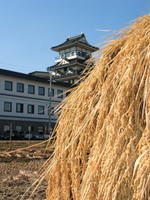Monday, October 17, 2005
Rice in Inakadate • 田舎館での米
 This is the first of several blogs exploring the use of land here in Inakadate. Unless you are very far away, it shouldn't surprise you that most of the land in Inakadate is devoted to agriculture. Thevillage of Inakadate is sandwiched between the relatively large cities of Hirosaki and Kuroishi, but it is still very rural and agriculture.
This is the first of several blogs exploring the use of land here in Inakadate. Unless you are very far away, it shouldn't surprise you that most of the land in Inakadate is devoted to agriculture. Thevillage of Inakadate is sandwiched between the relatively large cities of Hirosaki and Kuroishi, but it is still very rural and agriculture.これは、田舎館村の土地の使い方を見るブログの1つ目です。遠い外国にいない限り、皆は田舎館の土地利用とはやっぱり農業だということが想像できると思います。田舎館は弘前市と黒石市という割りと大きい町の間に挟まっているのですが、ここの村の人々は今でも主に農業に従事しています。
 Measured in area devoted to one crop, rice is clearly the main agricultural product in Inakadate. According to 2004 statistics nearly 900 hectares (2223 acres) of land in the village were devoted to rice paddies. I mentioned before that Inakadate is 22.31 square kilometers (1 km2 = 100 hectares). Calculate that out and you find that exactly 40% of the land in Inakadate is used for growing rice.
Measured in area devoted to one crop, rice is clearly the main agricultural product in Inakadate. According to 2004 statistics nearly 900 hectares (2223 acres) of land in the village were devoted to rice paddies. I mentioned before that Inakadate is 22.31 square kilometers (1 km2 = 100 hectares). Calculate that out and you find that exactly 40% of the land in Inakadate is used for growing rice. 作付面積から言えば、田舎館村のもっとも大事な農作物は米です。2004年の統計によると、村の土地の約900 ヘクタールが稲作の田んぼとなっています。こ前にも書きましたが、村の面積は22.31平方キロ((1 km2 = 100 ヘクタール) ですから、それを簡単に計算すると、村の土地の40%を水田が占めていると分かります。
 This is actually down some from previous years. I have statistics going back to 1993 and then the percentage was 50.21%. I think it would be safe to guess it was even higher further back. Probably the fall in the price of rice is mainly responsible for this change.
This is actually down some from previous years. I have statistics going back to 1993 and then the percentage was 50.21%. I think it would be safe to guess it was even higher further back. Probably the fall in the price of rice is mainly responsible for this change.実際に言うと、これは以前より減っています。僕の目の前に1993年までの統計がありますが、その時点では水田の割合は50 %でした。それ以前に遡ると、さらに高かったでだろうと推測することは間違いではないでしょう。この傾向は主に米の値下げによるものだと思います。
 Rice production has been an important part of life in Inakadate for a long time. This can best be seen in the village museum, where displays of the Yayoi era rice fields can be found. The discovery of these 2000 year old rice fields in Inakadate in the early 1980s changed Japanese history textbooks, which previously had said that rice wasn't grown in northern climates until years later.
Rice production has been an important part of life in Inakadate for a long time. This can best be seen in the village museum, where displays of the Yayoi era rice fields can be found. The discovery of these 2000 year old rice fields in Inakadate in the early 1980s changed Japanese history textbooks, which previously had said that rice wasn't grown in northern climates until years later.田舎館では、大昔から、稲作が生活の中で大きな位置を占めていました。これは、村の博物館で見ることができます。そこで田舎館村で発見された弥生時代の田んぼの展示をしています。1980年の前半に田舎館村で発掘されたこの 2000年前の水田によって、それまで「弥生時代には日本の北部では稲が作れなかった」と書かれていた教科書の記述は大きく覆たそうです。
 Another interesting thing about Inakadate's rice production, it wasn't too long ago that Inakadate was named one of the most productive rice producing municipalities in the nation. For 11 consecutive years ending in the late 1980's, Inakadate was ranked number one in the nation, producing more rice per hectare than any other place in the nation.
Another interesting thing about Inakadate's rice production, it wasn't too long ago that Inakadate was named one of the most productive rice producing municipalities in the nation. For 11 consecutive years ending in the late 1980's, Inakadate was ranked number one in the nation, producing more rice per hectare than any other place in the nation.田舎館のコメ生産についてもう一つ面白いことは、つい最近まで、全国の市町村に比べて、田舎館村の米の生産量が日本一だったことです。つまり、1980年代の後半まで、 11年間連続して、田舎館村の一反当たりの米の生産量(反集) が全国的にナンバー・ワンでした。
Rice is everywhere in Inakadate, but that isn't too different from most places in Japan. Soon we will look at other crops, which to me seemed a little more interesting when I first came to Inakadate.
この村では稲とその水田がどこに見てもありますが、それは日本全国どこでも同じような感じです。日本ではどこでも田んぼがあります。これからのこのブログは、ここの田舎館に来て、面白いなあと思った果汁などの農業を見てみたいと思います。
Free Web Counter